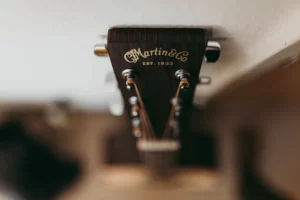- What is a classical guitar and how is it different from other guitars?
- Anatomy of a Classical Guitar
- How to string a classical guitar
- What are the benefits of using nylon strings?
- How often should you change your guitar strings?
- Additional tips for keeping your classical guitar in good condition
- Conclusion
If you’re a beginner guitarist, one of the first things you’ll need to learn is how to string a classical guitar. In this blog post, we’ll walk you through the process step-by-step so that you can get your instrument in playing shape in no time. By the end of this post, you’ll be able to confidently restring your guitar and keep it sounding great for years to come. Let’s get started!
Stringing a classical guitar takes time and patience to learn how to do, but it can be mastered through practice. It’s not difficult to string a classical guitar, but it’s important to do it correctly so that the instrument sounds its best.
What is a classical guitar and how is it different from other guitars?
Classical guitars are typically smaller in size than other acoustic guitars. They have a different shape, with a wider bottom and a more curved upper body. The strings are also placed closer together, which gives the instrument a different sound. Classical guitars are typically used for classical music, although they can be used for other styles of music as well.
Other acoustic guitars have a steel string, while classical guitars have nylon strings. This makes the sound of a classical guitar different than other acoustic guitars. Nylon strings are also softer than steel strings, which makes them easier on the hands.
Classical guitars also typically have a higher price tag than other acoustic guitars. They are often seen as a more prestigious instrument and are often used in professional settings.
Looking for the difference between classical and acoustic guitar. Check it out here Classical vs Acoustic Guitar.
Anatomy of a Classical Guitar
Classical guitars have six strings that are made of nylon. They are pitched in fifths, similar to a mandolin or a violin. The neck is made of hardwood, and the fretboard is made of ebony. The soundboard is usually made of spruce or cedar, and the body is made of different types of wood, depending on the manufacturer.
Classical guitars have a relatively large body, and the soundboard is arched. This design helps to project the sound of the guitar. The bridge is made of hardwood and is glued to the soundboard. It has four grooves that correspond to the strings on the guitar. The saddle is made of plastic or bone, and it rests in the grooves on the bridge. The strings are attached to the saddle, and they pass over the bridge before going to the tuning pegs.
The tuning pegs are located on the headstock of the guitar. They are used to tighten or loosen the strings, which changes the pitch of the strings. The nut is located at the top of the neck, and it supports the strings. The strings pass over the nut before they are attached to the tuning pegs.
Classical guitars usually have a rosette around the soundhole. The rosette is a decorative ring that is made of different materials, such as wood, plastic, or mother of pearl. It helps to protect the soundboard from damage.
Different Size of Classical Guitar
The classical guitar is a beautiful instrument, and it has been enjoyed by musicians for centuries. Classical guitars come in different sizes, including full size, 3/4 size, and 1/2 size. Full-size guitars are the traditional size and are the best choice for adults. 3/4 size guitars are for children or smaller adults, and 1/2 size guitars are for very small children.
If you are interested in learning to play the classical guitar, the best way to learn is to take lessons from a guitar instructor. But if you want to teach yourself, there are plenty of resources available online like Fender Play, including instructional videos and tutorials. Just be patient and take your time – learning to play the guitar is a process that takes time and practice. But eventually, you’ll be playing your favorite songs!
How to string a classical guitar

There are a few things you will need in order to string your classical guitar: a new set of strings, a screwdriver, and wire cutters. You will also need an Allen wrench, which is usually included in the string package. Following are the basic steps involve to string a classical guitar:
- Make sure that the strings that you are using are the correct gauge for your instrument. There are various gauges of strings available, so it’s important to get the right ones for your guitar.
- Cut the string to the correct length. You’ll want to make sure that the string is long enough to go from the tuning peg all the way down to the bridge on the guitar. If it’s too long, you can always trim it down later.
- Thread the string through the hole in the tuning peg. Be careful not to kink the string as you do this.
- Pull the string tight and wrap it around the peg a few times. Make sure that the string is tight against the peg so that it doesn’t slip off.
- Tune the string to the correct pitch by turning the tuning peg. There are usually markers on the guitar that will help you find the right notes.
- Repeat these steps for all of the strings on the guitar.
Once you’ve mastered how to string a classical guitar, it’s important to take care of your instrument so that it sounds its best. Be sure to keep the strings clean and well-tuned, and don’t let them go out of tune often. If you take care of your guitar, it will last for many years.
What are the benefits of using nylon strings?
There are a few key benefits that come with using nylon strings. Perhaps the most notable is that they provide a brighter, more articulate sound than traditional gut strings. They’re also more durable and less susceptible to climate changes, making them a good choice for touring musicians. Additionally, nylon strings are less prone to stretching than other types of strings, meaning they’ll hold their tune better over time.
While they can be a little more expensive than other types of strings, the benefits they provide are worth the investment. If you’re looking for a string that gives you a clear, bright sound with excellent durability, nylon strings are a great option.
How often should you change your guitar strings?
There is no definitive answer to this question. Depending on how often you play, how often you clean your strings, and what type of strings you use, they may need to be changed anywhere from every week to every few months. If you’re not sure when your strings need changing, there are a few telltale signs. If they’re starting to sound dull or scratchy, if they’re not holding tune very well, or if they’re starting to rust, then it’s time for a new set.
String quality is an important factor in the overall sound of your guitar. A set of good strings can make a big difference and will last longer than a set of cheap strings. That’s why it’s worth investing in a quality set of strings, even if they need to be changed more often. There are a variety of different types of strings available, so you can find the ones that work best for your playing style and guitar.
Additional tips for keeping your classical guitar in good condition
There are a few key things to keep in mind when it comes to preserving the condition of your classical guitar. First and foremost, always store your guitar in a climate-controlled environment. This will help to prevent the wood from drying out and warping. In addition, try to avoid exposing your guitar to extreme temperatures or humidity levels.
Another key thing to keep in mind is how you handle your guitar. Try not to bang it around or put too much pressure on the strings, as this can cause the wood to break down over time. Be especially careful when transporting your guitar, as it is vulnerable to being dropped or damaged in transit.
Finally, make sure to have your guitar regularly serviced by a professional luthier. This will help to ensure that all the components are in good working order and that the instrument is properly tuned and set up. By following these simple tips, you can help to keep your classical guitar in good condition for many years to come.
Conclusion
Now that you know how to string a classical guitar go ahead and give it a try! It might take a little bit of practice at first, but once you get the hang of it, you’ll be able to do it quickly and easily. Just be sure to follow the steps carefully, and use the right size strings for your guitar. Happy strumming!
Thank you for reading this post. We hope you found it helpful. If you have any questions or comments, please feel free to share them with us.







